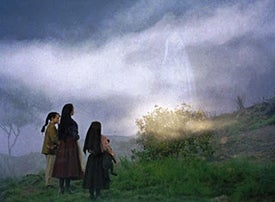This week I had some enforced rest and took the opportunity to watch the next film in my Netflix queue, which happened to be John Brahm’s The Miracle of Our Lady of Fatima (1952). I have been chasing after this film for over thirty years, ever since I interviewed Brahm in his Malibu home in the Summer of 1975. At the time, I was conducting interviews for an American Film Institure Oral History on German Émigrés in Hollywood after Hitler, funded by the Louis B. Mayer Foundation.
 The nephew of Germany’s greatest, late 19th century theater producer, Otto Brahm, Hans Brahm was born in Hamburg on August 17, 1893. His father was the actor, Ludwig Brahm, who was at the time engaged to the Hamburg State Theatre. He served on both the Western and Russian Fronts in the infantry in World War I, then moved to Berlin to act and direct at experimental theatres, like Die Tribune, where many German expressionist works were first premiered. He later switched to Vienna’s famed Burg Theatre, where he worked under Max Reinhardt. With the rise of Hitler in 1933, Hans Brahm fled to England, although neither he nor his uncle considered themsleves Jewish, the family having converted in the mid 19th century.
The nephew of Germany’s greatest, late 19th century theater producer, Otto Brahm, Hans Brahm was born in Hamburg on August 17, 1893. His father was the actor, Ludwig Brahm, who was at the time engaged to the Hamburg State Theatre. He served on both the Western and Russian Fronts in the infantry in World War I, then moved to Berlin to act and direct at experimental theatres, like Die Tribune, where many German expressionist works were first premiered. He later switched to Vienna’s famed Burg Theatre, where he worked under Max Reinhardt. With the rise of Hitler in 1933, Hans Brahm fled to England, although neither he nor his uncle considered themsleves Jewish, the family having converted in the mid 19th century.

In London, Hans became John and apprenticed as an assistant film director at Twickenham Studios. Brahm had previously worked as a dialoge coach on several early talkies, like The Ball (1931), with Dolly Haas, who he later married. (Haas would later go to New York and wed cartoonist Al Hirschfeld, their marriage lasting decades) Brahm’s first directorial effort was a remake of D.W. Griffith’s Broken Blossoms (1936), which was a major success; it was given to him after Griffith himself had been fired.
By 1937 he was in Hollywood at Columbia, but did his best work at 20th Century-Fox, including an anti-Nazi film I wrote about in my dissertation, Tonight We Raid Calais (1943). Andrew Sarris’ asssessment of Brahm’s subsequent Hollywood career is spot on: “ He hit his stride in the 40’s with a series of mood-drenched melodramas – The Lodger, Guest in the House, Hangover Square, The Locket, The Brasher Doublon. His quiet virtues of visual tastefulness and dramaic balance were unable to sustain his career.” (American Cinema, 1967) Well, not so fast, there is Fatima (Brahm’s only A picture), and a 15 year career in television, directing everything from M Squad (57-60) and The Naked City (59-62) to The Twilight Zone (59-64), Alfred Hitchcock Presents (59-65) and The Man From U.N.C.L.E. (65-68). Who knows what treasures may be found there?

The Miracle of Our Lady of Fatima faithfully visualizes the events that transpired in a Portuguese mountain village in the Summer of 1917, when the Virgin Mary appeared repeatedly to three children, culminating in the miracle of October 13, 1917. The site had by the year of the film’s production become a Roman Catholic shrine visited by millions of pilgrims on the anniversary of Mary’s appearance. Brahm creates many tableaux that reference medieval religious iconography,and his handling of the miralce is impressive, but there is also an anti-Communist subplot, which turns the first Portuguese Republic (1910-26), which also happened to be very anti-clerical into Russian style government of Commissars who are identified as the Baptists to Lenin’s 1917 revolution. On the other hand, Brahm includes scenes that visualize the sometimes overzealous behavior of masses of pilgrims and the commercialization exploiting that same impulse. Brahm himself had mixed feelings about the film. Here he is on June 16, 1975:
 John Brahm: "The Miracle of Fatima (1952) was a big hit, a world-wide success. But I did not find a Jennifer Jones (referring to Selznick’s discovery for his production of Franz Werfel’s The Song of Bernadette (1945). An old friend of mine, Bryan Foy had asked me – he’s a Catholic, I’m not – to direct it. I read the script and liked it. I thought, if we find somebody like Jennifer Jones…it will be a good thing. I didn’t find her, but it was still a good picture. The budget was $75,000 originally (Foy was a B film producer), then Warner Brothers upped the budget to $ 1.5 million. It made a killing and is still running all over the world. Anyway, I was only able at certain moments to realize personal elements, to release inner feelings through the visual. Because of the material itself, then the actors, there were limits, but there are scenes that touch my personal, but not in the same category as The Lodger or Hangover Square."
John Brahm: "The Miracle of Fatima (1952) was a big hit, a world-wide success. But I did not find a Jennifer Jones (referring to Selznick’s discovery for his production of Franz Werfel’s The Song of Bernadette (1945). An old friend of mine, Bryan Foy had asked me – he’s a Catholic, I’m not – to direct it. I read the script and liked it. I thought, if we find somebody like Jennifer Jones…it will be a good thing. I didn’t find her, but it was still a good picture. The budget was $75,000 originally (Foy was a B film producer), then Warner Brothers upped the budget to $ 1.5 million. It made a killing and is still running all over the world. Anyway, I was only able at certain moments to realize personal elements, to release inner feelings through the visual. Because of the material itself, then the actors, there were limits, but there are scenes that touch my personal, but not in the same category as The Lodger or Hangover Square."
Quite by accident, the double feature continued after The Miracle of Our Lady of Fatima with Santa (1931), one of the earliest Mexican sound features, directed by Hollywood silent star, Antonio Moreno. That film turned out to be a religious epic all its own, featuring Lupita Tovar as a prostitute with a halo and a martyrdom worthy of her name.






 Mobile Navigation
Mobile Navigation

